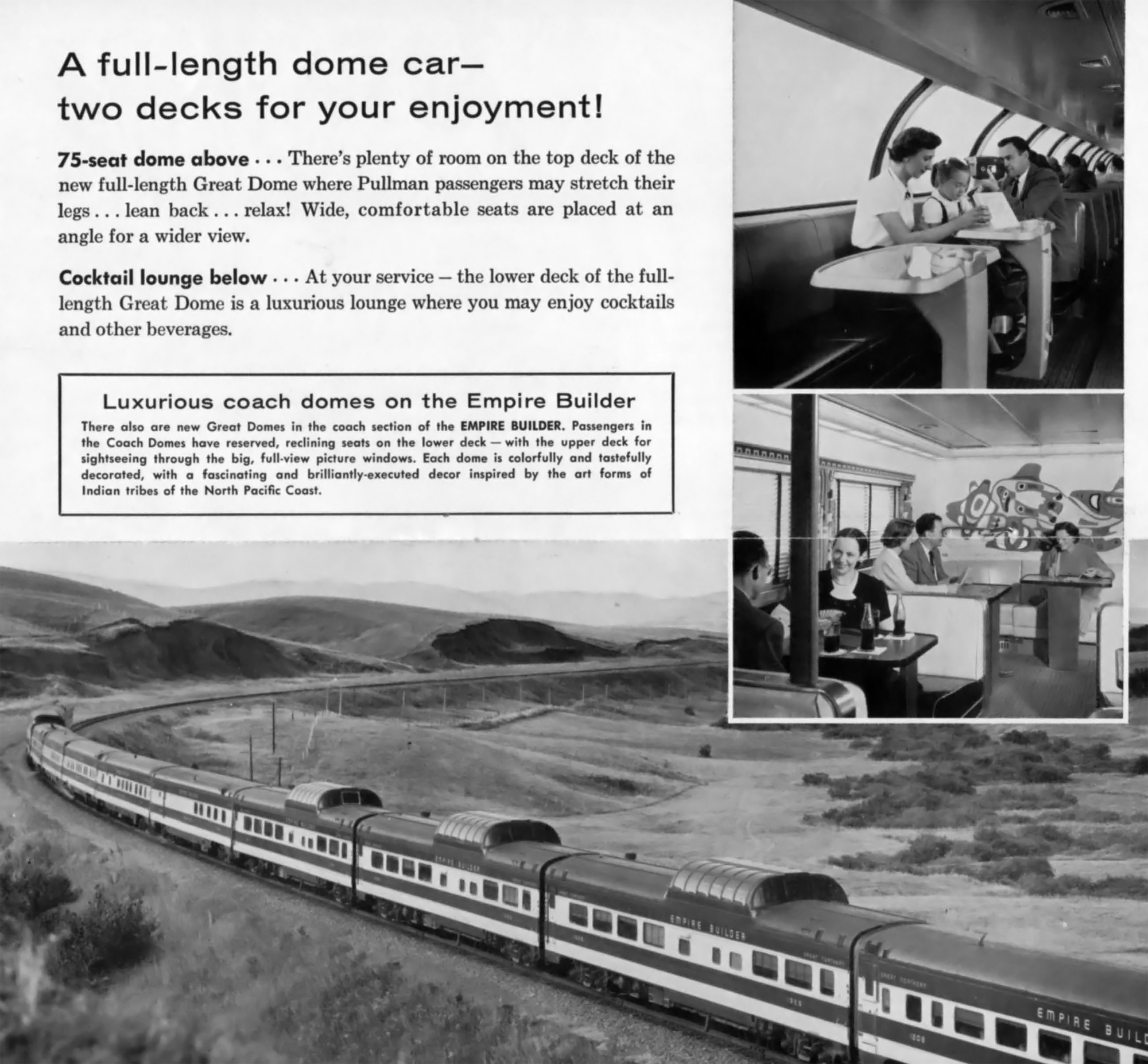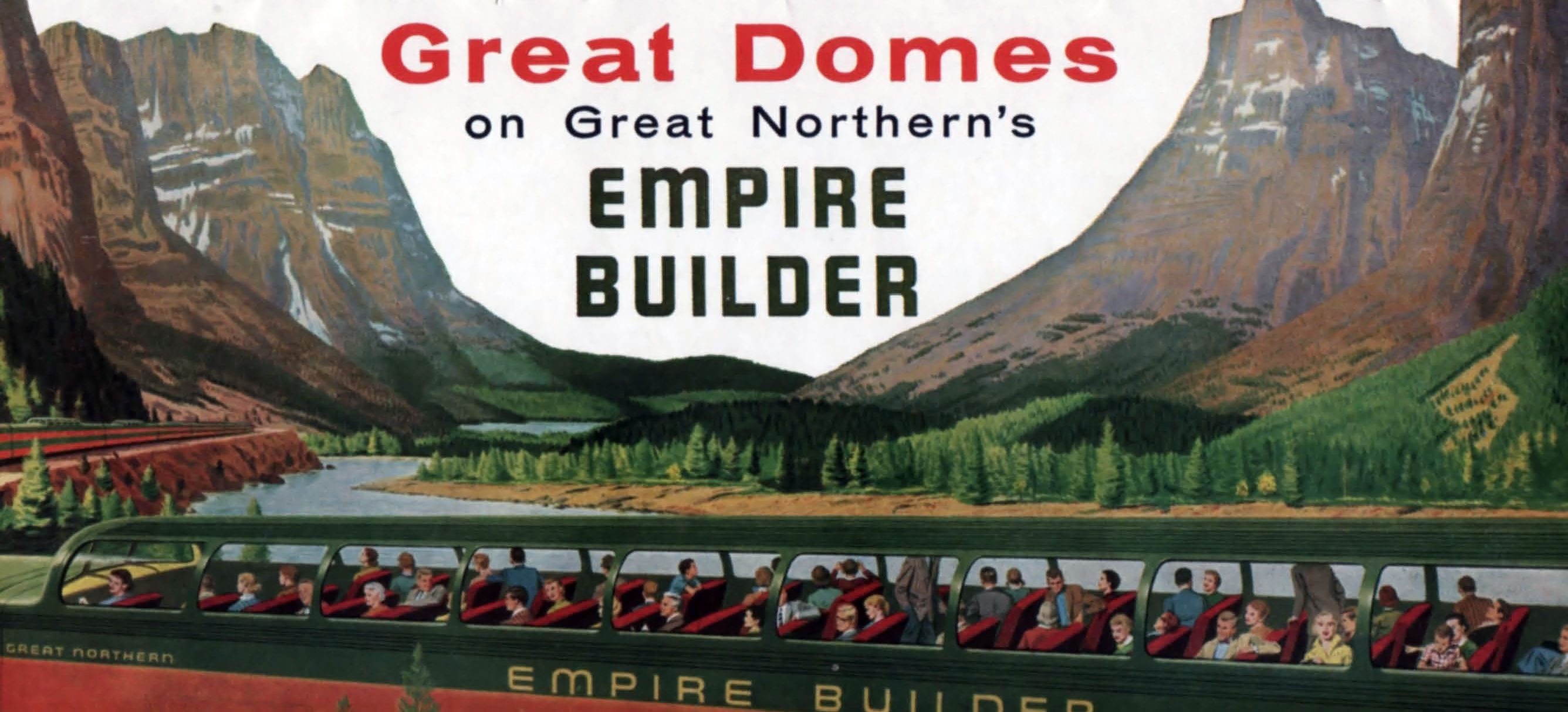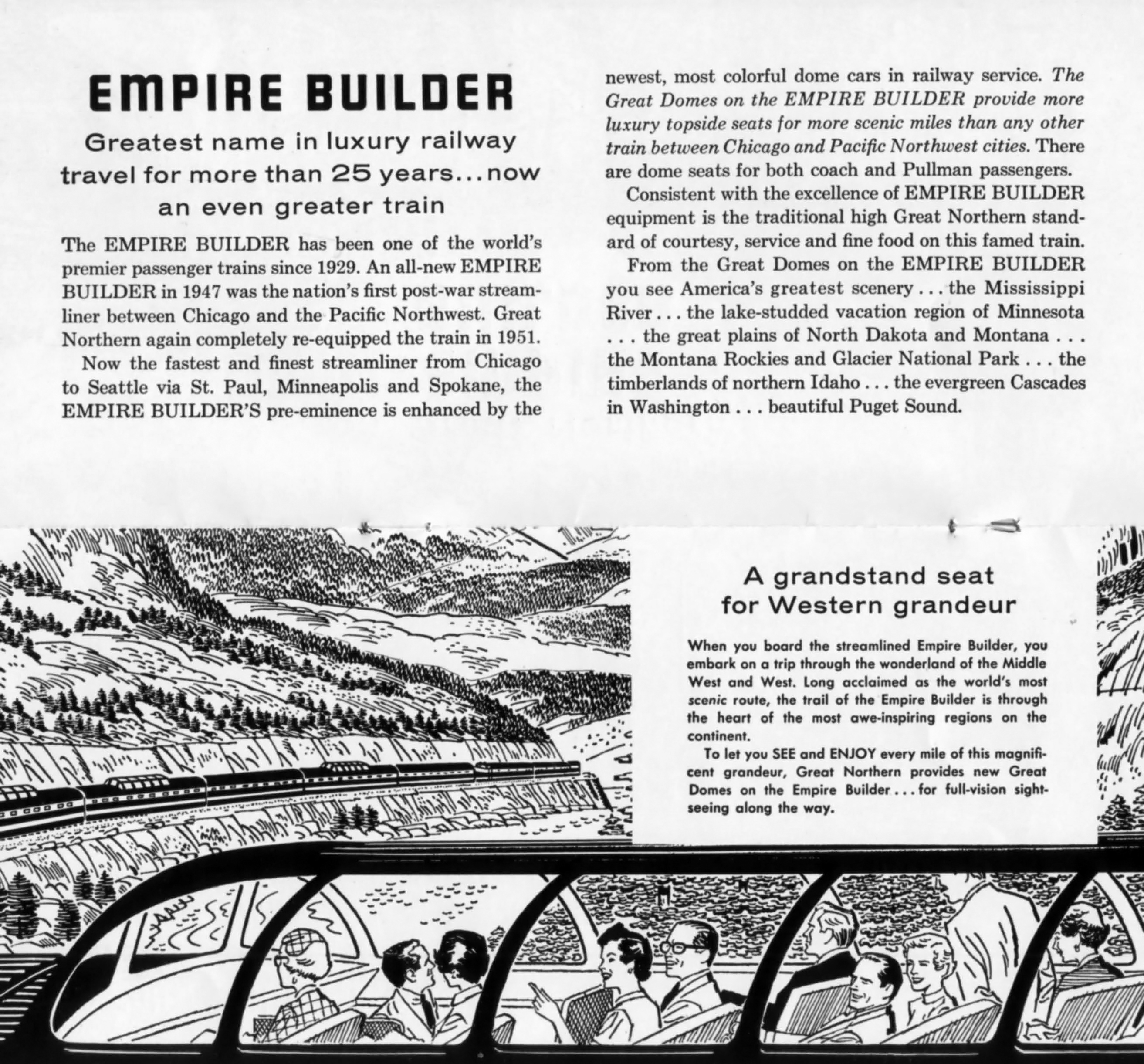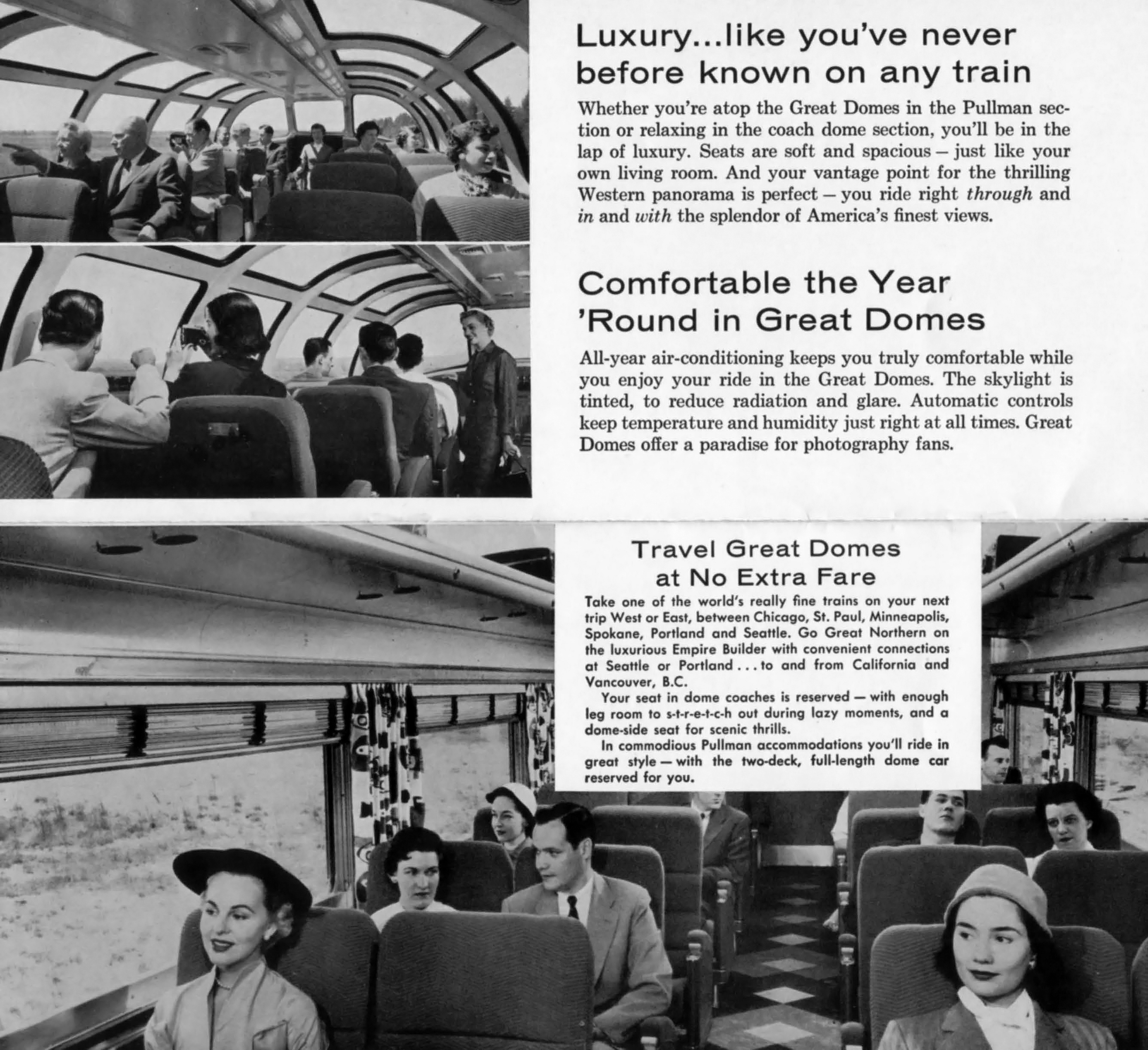Great Domes (Railcars): History, Roster, Photos
Published: February 5, 2025
By: Adam Burns
Introduced during the twilight of the passenger rail's golden age, the distinctive Great Domes symbolize the elegance and romance of train travel, offering panoramic views of the majestic landscapes they traversed.
Between 1953-1955, the Budd Company manufactured a fleet of six streamlined dome lounges for the Great Northern and the Chicago, Burlington & Quincy. They were built exclusively for the Empire Builder, operating in this capacity from 1955 until the cessation of private passenger rail service in 1971.
Amtrak incorporated all six cars into its fleet, where they continued to operate on the Empire Builder route until the late 1970s, when the introduction of new Superliner cars rendered them obsolete.
Thereafter, the Great Domes were reassigned to various routes within Amtrak's system, serving until the last one was retired in 2019. Their design bore a resemblance to the Big Domes that Budd also constructed for the Santa Fe.
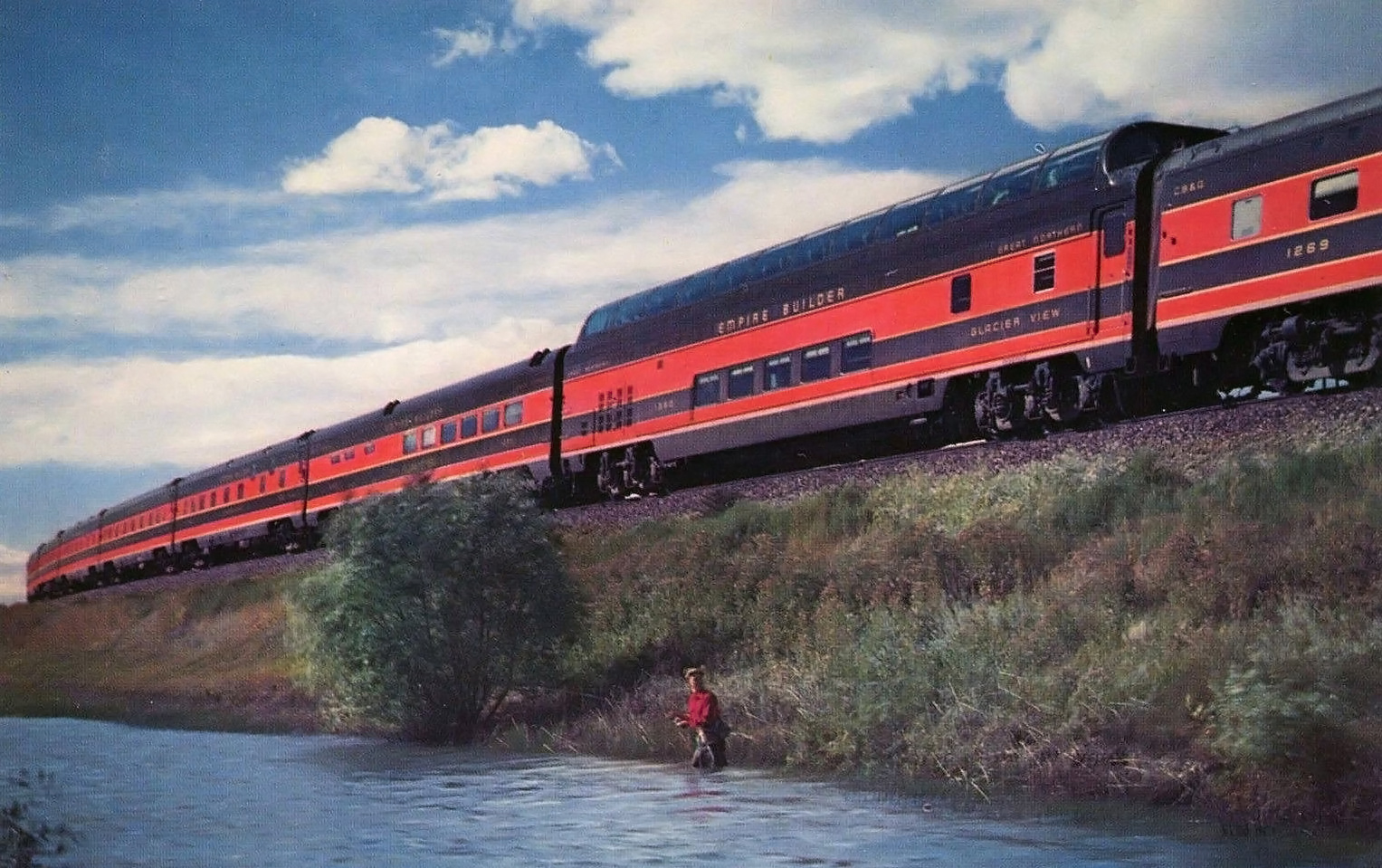 A Great Northern publicity photo of the "Empire Builder" east of Shelby, Montana in 1959. Front and center is full-length dome/lounge "Glacier View," manufactured by the Budd Company in 1955. Today, it is owned by BNSF Railway.
A Great Northern publicity photo of the "Empire Builder" east of Shelby, Montana in 1959. Front and center is full-length dome/lounge "Glacier View," manufactured by the Budd Company in 1955. Today, it is owned by BNSF Railway.Development
The Great Dome lounges were notable for their spacious upper-level glass dome that provided unparalleled views. This ambitious project was aimed at enhancing the passenger experience on the Empire Builder, GN's flagship service running between Chicago and the Pacific Northwest.
Built from stainless steel, each Great Dome car was 85 feet long and weighed 112 tons. Their most distinctive feature was the dome itself, a glass-enclosed viewing area that rose above the train's roofline and ran nearly its entirely length - a departure from other domes that only provided a roughly 30 foot dome area.
The Great Domes
| Road Number | Car Name |
|---|---|
| GN #1390 | Glacier View |
| GN #1391 | Ocean View |
| GN #1392 | Mountain View |
| GN #1393 | Lake View |
| GN #1394 | Prairie View |
| CB&Q #1395 | River View |
The Great Domes closely resembled the Big Dome lounges that Budd had designed for the Santa Fen in 1954, with the primary distinction being their smooth exteriors, lacking the fluted design of their predecessors.
On the upper level, there was seating arranged in a coach-style configuration accommodating 57 passengers, alongside a lounge area that could accommodate an additional 18 individuals on sofas and in booths.
The dome section allowed passengers to bask in the panoramic expanse of the Rocky Mountains, vast plains, and lush Pacific Northwest forests in comfort and style. The lower level was home to a cocktail lounge adorned with artwork by the Haida people, originating from the Pacific Northwest.
The dual-level configuration was not just an architectural novelty but an embodiment of a sophisticated travel experience, providing both communal spaces and intimate nooks for passengers.
The Great Domes were celebrated for their contribution to the cultural allure and appeal of cross-country rail travel. Passengers prized the opportunity to experience panoramic vistas unavailable by other means of transport, and these domes provided a scenic escape, combining the wonder of nature with the technological prowess of the time.
As such, Great Northern's efforts not only represented a significant leap in passenger comfort and aesthetic but also underscored the railroad's commitment to offering a unique travel experience that transcended mere transportation.
Service History
Interestingly, GN was initially reluctant to incorporate dome cars into its fleet. While the company enjoyed the highest patronage of the three Pacific Northwest railroads, management was concerned about the financial burden associated with the heating and cooling of the dome interiors, particularly given the challenging climatic conditions of extreme summers and winters.
They believed the Empire Builder, which had already undergone significant upgrades in 1947, and again in1951, could continue to attract passengers without the need for dome cars.
However, after learning that the Northern Pacific (Vista-Domes) and Milwaukee Road (Super Domes) were equipping their transcontinental trains with dome cars, the GN reconsidered its stance.
In 1953, they placed an order for six "Great Dome" cars and sixteen standard Vista Domes, providing the capacity to include one Great Dome and three Vistas on a typical Empire Builder consist. One of the latter, six were owned by the Chicago, Burlington & Quincy (CB&Q).
Decline
The heyday of dome cars was relatively brief. With the decline of passenger rail travel in the late 20th century, brought about by the rise of the interstate highway system and increased air travel, many of these cars were retired or repurposed.
When Amtrak was established in 1971, it acquired all six Great Domes from then-Burlington Northern, formed the previous year through the merger of the GN, CB&Q, and Northern Pacific.
The Great Domes continued to serve on the Empire Builder until October 28, 1979, when they and other single-level cars were replaced by Superliner and Hi-Level cars. Amtrak modified three of the cars to accommodate head end power (HEP), and these vehicles remained in service through the 1990s on the Auto Train.
One car, known as Ocean View, was retained by Amtrak as part of its business car fleet, and was also employed periodically on routes such as the Downeaster during the peak of the fall foliage season.
Ocean View was retired by Amtrak in 2019 due to the high costs and challenges of maintaining the aging car. Subsequently, it was sold to Paxrail in 2020 and entered into a lease-to-purchase agreement with RAILEXCO in early 2021, culminating in its full purchase by RAILEXCO.
As of late September 2022, Ocean View was operating on the Western Maryland Scenic Railroad under a lease from RAILEXCO, before it was sold to Canadian National at the end of 2022.
Legacy
In sum, the Great Dome railcars not only symbolize an era where luxury and practicality coalesced beautifully but also stand as a testament to the innovation and grandeur of the American passenger rail experience during its most illustrious period.
Recent Articles
-
Wisconsin Dinner Train Rides In North Freedom!
Jan 06, 26 10:18 PM
Featured here is a practical guide to Mid-Continent’s dining train concept—what the experience is like, the kinds of menus the museum has offered, and what to expect when you book. -
Pennsylvania Dinner Train Rides In Boyertown!
Jan 06, 26 06:48 PM
With beautifully restored vintage equipment, carefully curated menus, and theatrical storytelling woven into each trip, the Colebrookdale Railroad offers far more than a simple meal on rails. -
North Carolina ~ Murder Mystery ~ Dinner Train Ride
Jan 06, 26 11:26 AM
While there are currently no murder mystery dinner trains in the Tarheel State the Burgaw Depot does host a murder mystery dinner experience in September! -
Florida's - Murder Mystery - Dinner Train Rides
Jan 06, 26 11:23 AM
Florida, known for its vibrant culture, dazzling beaches, and thrilling theme parks, also offers a unique blend of mystery and fine dining aboard its murder mystery dinner trains. -
New Mexico's - Wine Tasting - Train Rides
Jan 06, 26 11:19 AM
For oenophiles and adventure seekers alike, wine tasting train rides in New Mexico provide a unique opportunity to explore the region's vineyards in comfort and style. -
Ohio's - Wine Tasting - Train Rides
Jan 06, 26 11:14 AM
Among the intriguing ways to experience Ohio's splendor is aboard the wine tasting trains that journey through some of Ohio's most picturesque vineyards and wineries. -
Connecticut's Thomas The Train Rides
Jan 06, 26 11:06 AM
For 2026, the tour stop at Essex brings Thomas (and Percy, too) to the historic Valley Railroad for a full day of events for the kids. -
Maryland's Thomas The Train Rides
Jan 06, 26 11:00 AM
In 2026, the B&O Railroad Museum in Baltimore welcomes the Let’s Rock, Let’s Roll Tour with four event days that combine a Thomas-themed excursion with other activities. -
Tennessee's Thomas The Train Rides
Jan 06, 26 10:51 AM
Set on the grounds of one of the Southeast’s best-known operating railroad museums, the Thomas the train event blends kid-friendly fun with the unmistakable sights, sounds, and atmosphere of a real wo… -
Georgia's Thomas The Train Rides
Jan 06, 26 10:44 AM
Day Out With Thomas is set to roll back into Cordele in 2026, bringing Thomas the Tank Engine and a full family festival to the SAM Shortline at Georgia Veterans Memorial State Park. -
Staten Island Rapid Transit
Jan 06, 26 10:02 AM
The Staten Island Rapid Transit has long served Staten Island since the 19th century and today is known as the Staten Island Railway. -
New York Dinner Train Rides In The Adirondacks!
Jan 05, 26 09:45 PM
Operating over a restored segment of the former New York Central’s Adirondack Division, the Adirondack Railroad has steadily rebuilt both track and public interest in passenger rail across the region. -
Ohio Dinner Train Rides On The CVSR!
Jan 05, 26 08:32 PM
While the railroad is well known for daytime sightseeing and seasonal events, one of its most memorable offerings is its evening dining program—an experience that blends vintage passenger-car ambience… -
Pennsylvania's - Wine Tasting - Train Rides
Jan 05, 26 01:08 PM
Wine tasting trains are a unique and enchanting way to explore the state’s burgeoning wine scene while enjoying a leisurely ride through picturesque landscapes. -
West Virginia - Wine Tasting - Train Rides
Jan 05, 26 01:02 PM
West Virginia, often celebrated for its breathtaking landscapes and rich history, offers visitors a unique way to explore its rolling hills and picturesque vineyards: wine tasting trains. -
Virginia - Wine Tasting - Train Rides
Jan 05, 26 12:58 PM
Wine tasting trains in Virginia provide just that—a unique experience that marries the romance of rail travel with the sensory delights of wine exploration. -
Utah - Wine Tasting - Train Rides
Jan 05, 26 12:37 PM
Utah, a state widely celebrated for its breathtaking natural beauty and dramatic landscapes, is also gaining recognition for an unexpected yet delightful experience: wine tasting trains. -
Kentucky Valentine's Train Rides
Jan 05, 26 12:31 PM
If you’re looking for a date night that feels a little more cinematic than the usual reservation-and-a-movie routine, Bardstown’s My Old Kentucky Dinner Train delivers the kind of evening you remember… -
Pennsylvania Valentine's Train Rides
Jan 05, 26 12:12 PM
Tucked amid the rolling farmland of Lancaster County, Pennsylvania, the Strasburg Rail Road stands as one of the most celebrated and successful heritage railroads in North America. -
New York's - Murder Mystery - Dinner Train Rides
Jan 05, 26 11:01 AM
New York State, renowned for its vibrant cities and verdant countryside, offers a plethora of activities for locals and tourists alike, including murder mystery train rides!

